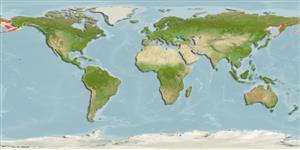Environment: milieu / climate zone / depth range / distribution range
Écologie
marin démersal; profondeur 7 - 87 m (Ref. 43939). Polar
Northwest Pacific: western Bering Sea off Cape Navarin; Sea of Okhotsk and northern Sea of Japan off Tatar Strait. Northeast Pacific: northeastern Bering Sea between St. Lawrence Island and Seaward Peninsula.
Taille / Poids / Âge
Maturity: Lm ? range ? - ? cm
Max length : 22.5 cm TL mâle / non sexé; (Ref. 43939)
Description synthétique
Clés d'identification | Morphologie | Morphométrie
Épines dorsales (Total) : 9 - 11; Rayons mous dorsaux (Total) : 15 - 16; Épines anales: 0; Rayons mous anaux: 12 - 14.
Found on sandy bottoms (Ref. 43939).
Life cycle and mating behavior
Maturities | Reproduction | Spawnings | Egg(s) | Fecundities | Larves
Mecklenburg, C.W., T.A. Mecklenburg and L.K. Thorsteinson, 2002. Fishes of Alaska. American Fisheries Society, Bethesda, Maryland. xxxvii +1037 p. (Ref. 43939)
Statut dans la liste rouge de l'IUCN (Ref. 130435)
Menace pour l'homme
Harmless
Utilisations par l'homme
Outils
Articles particuliers
Télécharger en XML
Sources Internet
Estimates based on models
Preferred temperature (Ref.
123201): -0.8 - 3.3, mean 1.6 °C (based on 196 cells).
Phylogenetic diversity index (Ref.
82804): PD
50 = 1.0000 [Uniqueness, from 0.5 = low to 2.0 = high].
Bayesian length-weight: a=0.01000 (0.00244 - 0.04107), b=3.04 (2.81 - 3.27), in cm total length, based on all LWR estimates for this body shape (Ref.
93245).
Niveau trophique (Ref.
69278): 3.5 ±0.5 se; based on size and trophs of closest relatives
Résilience (Ref.
120179): Milieu, temps minimum de doublement de population : 1,4 à 4,4 années (Preliminary K or Fecundity.).
Fishing Vulnerability (Ref.
59153): Low vulnerability (13 of 100).
